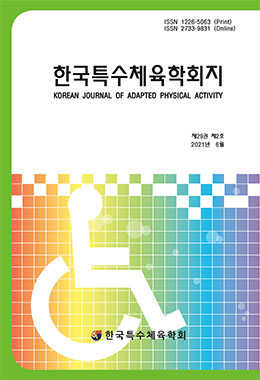본 연구는 사용자 참여 디자인을 통해 3D 프린팅 개인맞춤형 인솔을 제작하고 그것이 첨족 뇌성마비 장애인의 보행에 어떤 경험과 의미를 주는지 탐색하고 확인하는데 목적이 있다. 연구는 수도권에 거주중인 남, 여 만 8세 이상 뇌성마비 장애인 중 보행과 면담이 가능하고 연구 참여에 자발적으로 동의한 자 3명을 대상으로 2020년 7월부터 11월까지 진행되었다. 인솔 착용 기간 중 참여관찰과 심층 면담이 진행되었으며 수집된 자료는 개방적 코딩과 귀납적 주제분석을 실시하였다. 더불어 질적 연구 결과의 보완과 더욱 충실한 논의 제공을 위해 개인맞춤형 인솔의 착용 전과 착용 후 상태에서 근전도, 지면반력과 같은 운동역학적 변인에 대한 분석을 추가적으로 진행하였다. 연구는 전문가 집단의 지속적 검토를 받으며 진행하였으며 분석 자료에 대한 연구참여자의 확인 및 삼각검증이 이루어졌다. 이러한 과정을 통해 사용자 참여 디자인을 적용한 3D 프린팅 개인맞춤형 인솔의 제작 절차에 대한 연구문제 1의 핵심 주제어는 ‘손뼉이 마주치다’, ‘첫발을 내디디며’, ‘한 걸음씩 나아가다’, ‘언덕 위에 다다르다’, ‘고생 끝에 낙’으로 도출되었다. 또한 사용자 참여 디자인을 적용한 3D 프린팅 개인맞춤형 인솔의 제작 및 사용과정에서 첨족 뇌성마비 장애인들이 겪는 경험에 대한 연구문제 2의 핵심 주제어는 ‘유레카: 새로운 경험’, ‘작은 소용돌이: 나에게 찾아온 것들’로 확인되었다. 연구참여자들은 개인맞춤형 인솔이 기존에 접해왔던 일반 인솔, 보조기 등과는 다른 새로운 제품이라는 인식을 갖고 있었으며, 3D 프린팅과 사용자 참여 디자인 방식을 통해 본인이 원하는 인솔을 스스로 만들고 사용하는 것 역시 기존에 경험해보지 못한 새로운 경험으로 인식하고 있었다. 또한 3D 프린팅 개인맞춤형 인솔을 착용하며 신체적, 심리적으로 변화하는 자신의 모습을 자각하고 있었다. 근전도와 지면반력의 운동역학적 변인의 분석 결과는 연구참여자들이 언급한 심리적 변화에 대한 내용을 실제적으로 뒷받침하고 있었다. 본 연구를 통해 향후 3D 프린팅 기술을 적용한 맞춤형 인솔 착용이 뇌성마비인들의 보행에 줄 수 있는 긍정적 영향을 확인하였으며, 이를 통해 일상생활 및 운동과 관련된 신체활동의 범위를 확장시킬 수 있을 것으로 사료된다.
This study aims to produce 3D printing personalized insoles through the process of participation in the design of the individual users themselves and to explore what experiences and meanings are given to the walking of people with cerebral palsy with equinus deformity. To achieve this goal, the researcher selected three people who voluntarily agreed to participate in the research among men and women over 8 years old living in the metropolitan area. The research process was conducted from July 2020 to November 2020. Participant observations and in-depth interviews were conducted during the period of wearing the insole, and the researcher transcribed all the collected data and carried out an open coding and inductive thematic analysis. Furthermore, to complement the results of the qualitative study and provide more faithful discussion, additional biomechanical analysis such as EMG and GRF were conducted before and after wearing a personalized insole. In this study, the procedure was carried out under continuous review by an expert group, and to secure the truth of the study, the affirmation of the analysis data by research participants and the triangulation was used. Through this process, 5 core themes of research question 1 on the manufacturing process of 3D printing personalized insoles applying user participation design, 'Bursts of applause', ‘Taking the first step’, ‘Going one step at a time’, ‘Reach on the hill’, ‘Every cloud has a silver lining’ were derived. In addition, 2 core themes of research question 2 on the experiences of people with cerebral palsy with equinus deformity in the process of making and using 3D printing personalized insoles with user participation design, ‘Eureka: a new experience’ and 'Little whirlpools: things that come to me’ were derived. The study participants were aware of their changing physically and psychologically while wearing 3D printing personalized insoles, and the results of the biomechanical analysis supported what the research participants mentioned about these changes. Through this study, it is believed that wearing customized insoles applying 3D printing technology in the future can have a positive effect on the gait of cerebral palsy, and through this, it is expected that the range of physical activities related to daily life and exercise can be expanded.




